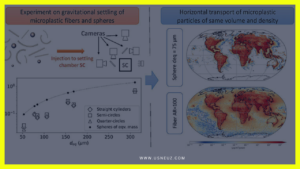
Microplastic Fibers: How Far Do They Travel 2024?
Researchers from the University of Vienna and the Max Planck Institute for Dynamics and Self-Organisation in Göttingen have shed light on the long-range transport of microplastic fibers in the atmosphere, revealing that their travel distance depends significantly on particle shape. The study, published in Environmental Science & Technology, indicates that while spherical particles settle quickly, microplastic fibers may reach as far as the stratosphere.
In laboratory experiments overseen by Mohsen Bagheri of the Max Planck Institute, scientists found that microplastic fibers settle much slower than spheres of the same mass. The lack of available data on the dynamics of these fibers in the air has been a challenge, but advances in 3D printing and a novel experimental setup allowed researchers to track individual microplastics in the air, filling a crucial knowledge gap.

The researchers implemented their experimental results into a global atmospheric transport model, demonstrating significant differences in the settling process between fibers and spherical particles. Fibers with lengths of up to 1.5 mm, according to the model, could reach Earth’s most remote regions, including the stratosphere. In contrast, spheres of the same mass settled much closer to their plastic source regions.
Daria Tatsii from the University of Vienna highlighted the significance of the findings, stating, “With the novel laboratory experiments and modeling analysis, we certainly reduce uncertainties about the atmospheric transport of fibers and can finally explain why microplastics reach very remote regions of the planet.” Importantly, the study suggests that the analysis not only applies to microplastics but also to other particles such as volcanic ash, mineral dust, and pollen.
Additionally, the research indicates that plastic fibers could reach greater heights in the atmosphere than spheres of the same mass. Andreas Stohl of the University of Vienna expressed concern over potential implications for cloud processes and stratospheric ozone. He emphasized the need for more data, stating, “We do not even know how much plastic, and in which sizes and shapes, is emitted into the atmosphere, and we also do not know what happens to it under the extreme conditions of the upper troposphere and stratosphere.”
Despite uncertainties, the study underscores the importance of considering the unique shapes of microplastic fibers when assessing their environmental impact. As global plastic production continues to rise, the researchers emphasize the urgency of further studies to investigate the potential influence of microplastics on the atmosphere.
Researchers from the University of Vienna and the Max Planck Institute for Dynamics and Self-Organisation in Göttingen have shed light on the long-range transport of microplastic fibers in the atmosphere, revealing that their travel distance depends significantly on particle shape. The study, published in Environmental Science & Technology, indicates that while spherical particles settle quickly,…
Researchers from the University of Vienna and the Max Planck Institute for Dynamics and Self-Organisation in Göttingen have shed light on the long-range transport of microplastic fibers in the atmosphere, revealing that their travel distance depends significantly on particle shape. The study, published in Environmental Science & Technology, indicates that while spherical particles settle quickly,…